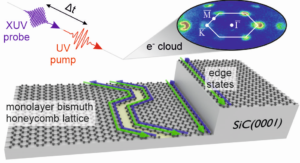
In the quest to continue Moore´s law, utilizing the electron´s spin degree of freedom poses a promising approach. A material class that intrinsically enables efficient spintronic applications are quantum spin Hall (QSH) insulators, also termed 2D topological insulators, as they allow for dissipationless spin-currents in their edges. However, exploiting the transport properties of such edge states is so far restricted to cryogenic temperatures, as only a few QSH materials with small bulk band gaps are available. Here, graphene-like 2D structures of heavy atoms, most notably bismuthene, i.e., a honeycomb lattice of Bi atoms on a semiconductor substrate, offer a route to QSH conductivity far beyond room-temperature due to their large spin-orbit coupling.
In our recent study [Maklar et al., Nano Letters (2022)], we present a detailed investigation of the ultrafast electron dynamics of bismuthene using time- and angle-resolved photoemission spectroscopy and scanning tunneling microscopy. A detailed mapping of the transiently occupied conduction band after optical excitation confirms the predicted large indirect bulk band gap, a prerequisite for high-temperature QSH applications. Intriguingly, within the bulk band gap, we observe signatures of the elusive edge states and track their decisive role in the ultrafast relaxation of photocarriers.